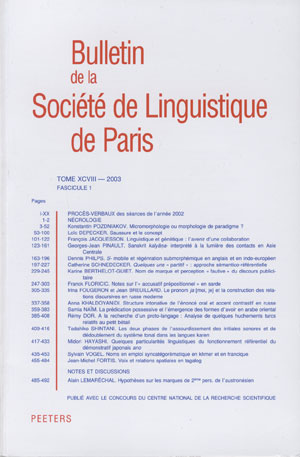 previous article in this issue previous article in this issue | next article in this issue  |

Preview first page |
Document Details : Title: Réflichi et moyen dans les langues balkaniques Author(s): ASSENOVA, Petya , GUENTCHÉVA, Zlatka Journal: Bulletin de la Société de Linguistique de Paris Volume: 103 Issue: 1 Date: 2008 Pages: 311-331 DOI: 10.2143/BSL.103.1.2033493 Abstract : Cet article propose une analyse comparée des propriétés syntaxiques et sémantiques des formes verbales du moyen (grec et albanais) et des formes verbales avec un clitique réflexif (bulgare et roumain) encodant les valeurs réfléchie, moyenne et médio-passive. Cette analyse montre que l’interprétation d’une construction dépend de plusieurs facteurs: les propriétés sémantiques du verbe qui donne naissance au verbe dérivé, la façon dont le marqueur moyen ou le clitique réflexif s’intègre dans les propriétés sémantiques du verbe, la relation qui s’établit entre la signification verbal et les propriétés des termes nominaux. A la différence du pronom réfléchi fort qui situe le procès par rapport à «soi» et qui a pour fonction de mettre à «égalité» l’agent avec les autres participants, la fonction principale du morphème moyen ou du clitique réflexif consiste à ne pas différencier l’agent et d’autre participant (patient, bénéficiaire ou destinataire) impliqué dans la relation prédicative. Dans le passage d’une construction transitive à une construction intransitive, la signification du verbe dérivé peut être fortement modifiée et la délimitation entre les différentes valeurs d’une construction est parfois très délicate et fortement tributaire du contexte. Sur le plan diachronique, ces constructions font apparaître deux étapes dans l’évolution des langues balkaniques: une formation verbale complètement morphologisée (grec et albanais) et une formation verbale morphologique (bulgare et roumain). This article puts forward a comparative analysis of the syntactic and semantic properties of middle-voice verb forms on the one hand (Greek and Albanian), and verb forms containing a reflexive clitic encoding reflexive, middle and mediopassive meanings on the other hand (Bulgarian and Romanian). Our analysis shows that the interpretation of a given construction is determined by several factors: the semantic properties of the verb giving rise to the derived verb, the manner in which the middle marker or reflexive clitic is integrated in the semantic properties of the verb, the relation between the semantics of the verb and the properties of the nominal terms. Contrary to the intensive reflexive pronoun which situates the process in terms of one’s 'self', and which establishes 'equality' between the agent and the other participants, the main function of the middle morpheme and reflexive clitic is to establish the non-differentiation between the agent and some other participant implicated in the predicative relation (patient, beneficiary or receiver). In the switch from a transitive to an intransitive construction, the meaning of the derived verb may be considerably modified and the dividing lines between the various meanings of a construction can be very difficult to draw, and be highly context dependent. Diachronically, these constructions show two stages in the evolution of the Balkan languages: entirely morphologized verb formation (Greek and Albanian) and morphological verb formation (Bulgarian and Romanian). |
|


